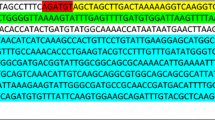Abstract
Astaxanthin has been widely used as a feed supplement in poultry and aquaculture industries. One challenge for astaxanthin production in bacteria is the low percentage of astaxanthin in the total carotenoids. An obligate methanotrophic bacterium Methylomonas sp. 16a was engineered to produce astaxanthin. Astaxanthin production appeared to be dramatically affected by oxygen availability. We examined whether astaxanthin production in Methylomonas could be improved by metabolic engineering through expression of bacterial hemoglobins. Three hemoglobin genes were identified in the genome of Methylomonas sp. 16a. Two of them, thbN1 and thbN2, belong to the family of group I truncated hemoglobins. The third one, thbO, belongs to the group II truncated hemoglobins. Heterologous expression of the truncated hemoglobins in Escherichia coli improved cell growth under microaerobic conditions by increasing final cell densities. Co-expression of the hemoglobin genes along with the crtWZ genes encoding astaxanthin synthesis enzymes in Methylomonas showed higher astaxanthin production than expression of the crtWZ genes alone on multicopy plasmids. The hemoglobins likely improved the activity of the oxygen-requiring CrtWZ enzymes for astaxanthin conversion. A plasmid-free production strain was constructed by integrating the thbN1–crtWZ cassette into the chromosome of an astaxanthin-producing Methylomonas strain. It showed higher astaxanthin production than the parent strain.





Similar content being viewed by others
References
Arakane K (2002) Superior skin protection via astaxanthin. Carotenoid Science 5:21–24
Chew BP, Park JS (2004) Carotenoid action on the immune response. J Nutr 134:257S–261S
Fraser PD, Miura Y, Misawa N (1997) In vitro characterization of astaxanthin biosynthetic enzymes. J Biol Chem 272:6128–6135
Frey AD, Kallio PT (2003) Bacterial hemoglobins and flavohemoglobins: versatile proteins and their impact on microbiology and biotechnology. FEMS Microbiol Rev 27:525–545
Guerin M, Huntley ME, Olaizola M (2003) Haematococcus astaxanthin: applications for human health and nutrition. Trends Biotech 21:210–216
Kallio PT, Kim DJ, Tsai PS, Bailey JE (1994) Intracellular expression of Vitreoscilla hemoglobin alters Escherichia coli energy metabolism under oxygen-limited conditions. Eur J Biochem 219:201–208
Khosla C, Curtis JE, DeModena J, Rinas U, Bailey JE (1990) Expression of intracellular hemoglobin improves protein synthesis in oxygen-limited Escherichia coli. Biotechnol (N Y) 8:849–853
Miki W, Yamaguchi K, Konosu S (1982) Comparison of carotenoids in the ovaries of marine fish and shellfish. Comp Biochem Physiol B 71:7–11
Nilsson M, Kallio PT, Bailey JE, Bulow L, Wahlund KG (1999) Expression of Vitreoscilla hemoglobin in Escherichia coli enhances ribosome and tRNA levels: a flow field-flow fractionation study. Biotechnol Prog 15:158–163
Nishikawa Y, Minenaka Y, Ichimura M, Tatsumi K, Nadamoto T, Urabe K (2005) Effects of astaxanthin and vitamin C on the prevention of gastric ulcerations in stressed rats. J Nutr Sci Vitaminol (Tokyo) 51:135–141
Odom JM, Jessie K, Knodel E, Emptage M (1991) Immunological cross reactivities of adenosine 5′ phosphosulfate reductases from sulfate-reducing and sulfide-oxidizing bacteria. Appl Environ Microbiol 57:727–733
Pathania R, Navani NK, Rajamohan G, Dikshit KL (2002) Mycobacterium tuberculosis hemoglobin HbO associates with membranes and stimulates cellular respiration of recombinant Escherichia coli. J Biol Chem 277:15293–15302
Sambrook J, Fritsch EF, Maniatis T (1989) Molecular cloning: a laboratory manual, 2nd edn. Cold Spring Harbor Laboratory Press, Cold Spring Harbor, NY
Sharpe PL et al (2006) The use of transposon promoter-probe vectors and a markerless chromosomal integration system in the metabolic engineering of the obligate methanotroph Methylomonas sp. strain 16a for enhanced C40 carotenoid synthesis. Appl Environ Microbiol, submitted
Tao L, Schenzle A, Odom JM, Cheng Q (2005) Novel carotenoid oxidase involved in biosynthesis of 4,4′-diapolycopene dialdehyde. Appl Environ Microbiol 71:3294–3301
Tao L, Wilczek J, Odom JM, Cheng Q (2006) Engineering a beta-carotene ketolase for astaxanthin production. Metab Eng 8:523–531
Tsai PS, Nageli M, Bailey JE (2002) Intracellular expression of Vitreoscilla hemoglobin modifies microaerobic Escherichia coli metabolism through elevated concentration and specific activity of cytochrome o. Biotechnol Bioeng 79:558–567
Tuse D (1984) Single-cell protein: current status and future prospects. Crit Rev Food Sci Nutr 19:273–325
Visser H, van Ooyen AJ, Verdoes JC (2003) Metabolic engineering of the astaxanthin-biosynthetic pathway of Xanthophyllomyces dendrorhous. FEMS Yeast Res 4:221–231
Ward N et al (2004) Genomic insights into methanotrophy: the complete genome sequence of Methylococcus capsulatus (Bath). PLoS Biol 2:e303
Wittenberg JB, Bolognesi M, Wittenberg BA, Guerin M (2002) Truncated hemoglobins: a new family of hemoglobins widely distributed in bacteria, unicellular eukaryotes, and plants. J Biol Chem 277:871–874
Ye RW et al (2006) Construction of the astaxanthin biosynthetic pathway in a methanotrophic bacterium Methylomonas sp. strain 16a. J Ind Microbiol Biotech, submitted
Acknowledgment
We are grateful to Deana DiCosimo for introducing the 24-well block culturing method for growing Methylomonas. We thank Martin Odom for insightful discussions on oxygen requirement for Methylomonas. We are also thankful to Robert Scott for sharing the patent on DO effect on carotenoid production.
Author information
Authors and Affiliations
Corresponding author
Rights and permissions
About this article
Cite this article
Tao, L., Sedkova, N., Yao, H. et al. Expression of bacterial hemoglobin genes to improve astaxanthin production in a methanotrophic bacterium Methylomonas sp.. Appl Microbiol Biotechnol 74, 625–633 (2007). https://doi.org/10.1007/s00253-006-0708-8
Received:
Revised:
Accepted:
Published:
Issue Date:
DOI: https://doi.org/10.1007/s00253-006-0708-8




